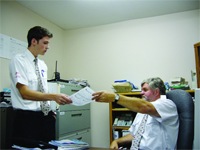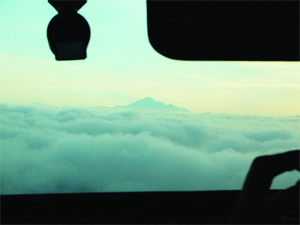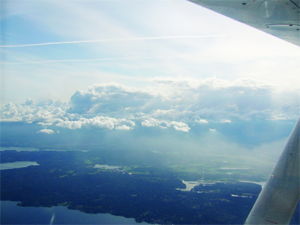
Features
Safety
VFR in IMC: Why good pilots fly in bad weather
If experience is the best teacher, my most memorable lesson was in the right seat of a Cessna 172 over the Coast Mountains. The failed VFR descent between layers had put me in a tough spot – clouds were filling the windscreen, masking the 5,000-foot peaks in their mist as I watched my shaky altimeter struggle upward past 2,500 feet.
January 30, 2008 By James Marasa
 |
| Paul Harris discusses the weather with instructor Mark Brown before authorizing a VFR training flight. |
If experience is the best teacher, my most memorable lesson was in the right seat of a Cessna 172 over the Coast Mountains. The failed VFR descent between layers had put me in a tough spot – clouds were filling the windscreen, masking the 5,000-foot peaks in their mist as I watched my shaky altimeter struggle upward past 2,500 feet. While making every attempt to come to terms with the greyed-out win-dows, my shattered ego and the crackling voice of the controller told me I was facing the very real possibility of becoming a statistic – one of those “foolish” pilots who pressed on into conditions he had no business being in, endangering those on the aircraft, persons and property on the ground and other aircraft in flight (at least that’s what the suspension letter from Transport Canada said). As trees suddenly began to smash against the bottom of the plane, I resigned myself to having committed one of aviation’s deadly sins: controlled flight into terrain in IMC (Instrument Meteorological Conditions).
Although these accidents occur with striking regularity, no one really believes it will happen to himself. Having lived the nightmare, I am convinced this way of thinking is part of the problem. Five years ago, I was one of the universal breed of over-confident 300/500-hour pilots who thought the white shirt, black tie and Instructor Rating meant I had arrived in the aviation world. However, as I touched down 30 minutes after brushing up against the side of a mountain in cloud, my confidence was as beat up as the bottom of the aircraft. I may have lost my Instructor Rating that day, but I gained something altogether more valuable – a new perspective on Pilot Decision-Making.
In 1990, the Transportation Safety Board of Canada (TSB) conducted a safety study examining the occurrence of VFR in IMC incidents in Canadian-registered aircraft between 1976 and 1985. Out of 5,994 recorded accidents, VFR in adverse weather accounted for only 352, a mere 6% of the total, yet was responsible for an astonishing 26% of all reported fatalities. The statistics from 1996-2005 tell an even more tragic tale with more than 36% of all fatal airplane accidents deemed the result of controlled flight into terrain. Practically speaking, no other type of accident is responsible for claiming more lives than pilots unintentionally flying a mechanically sound aircraft into the ground. We may not believe it’s going to happen to us, but it sure happens to a lot of other people. Visual flight into adverse weather is the precursor to the vast majority of these tales with “pilot error,” “lack of training,” or “utter foolishness” playing the usual suspects. Though such allegations provide convenient answers, they do little to solve the problem of why this type of accident plagues the aviation community with such disturbing frequency.
 |
| Mount Baker rising through an overcast layer as seen from a Beech Duchess on approach to Abbotsford International. |
Simply stated, if a pilot can avoid flying into unfavourable conditions, he or she will never face this problem. Then why, for that matter, should instrument training be required for a private licence? Can’t pilots just adhere to their personal limitations and avoid these disasters altogether? History suggests that as a whole, we can’t, and when we cross the line, there are often grave consequences. Imagine a pilot with no instrument training, entering cloud and trying to maintain control of the aircraft. Researchers at the University of Illinois tested this scenario, and according to their findings, that pilot would likely be dead in less time than it will take you to read this article.
So who are these “rogue aviators” who fly on until they can no longer see the ground, leaving only a trail of wreckage for investigators to piece together? They aren’t all flying out of Illinois – an honest pilot will admit it could happen to any one of us. In fact, the problem may lie in the very nature of who we are.
Paul Harris, manager of flight operations at Pacific Flying Club in Delta, BC, has observed thousands of decisions play out from the right seat. “Pilots are, by nature, optimistic risk-takers with a high commitment to task completion,” he says A Designated Flight Test Examiner and Class 1 Instructor, his experience has afforded him ample opportunity to peer into the pilot psyche. Harris considers aviation a “natural self-selecting process” that draws a certain type of candidate to the trade.
“Pessimists don’t get into airplanes,” he laughs.
 |
| A band of weather beginning to form over Nanaimo, BC. |
Our rosy world view might be what gets us airborne, but it can also be detrimental to our safe return. The TSB report says nearly 80% of all VFR in IMC accidents studied occurred during the enroute phase of flight. Presumably the weather had deteriorated, yet the pilots decided to continue on with measurable consequences. Did they fail to recognize the changing weather ahead or were they just reckless? Neither. Harris believes it can be chalked up to the power of positive thinking. He suggests that in such instances the pilot likely believed the weather would get better, so therefore chose to press on in hope of finding improving conditions. It would be tempting to dismiss such sanguinity as a by-product of inexperience, but this unwarranted optimism is not only restricted to low-time general aviation pilots. Experience can bring its own set of obstacles to clear thinking such as expectancy and complacency. Roughly 35% of the accidents in the report occurred in commercial operations and nearly 1 in 5 involved pilots with over 3,000 hours.
While all are susceptible to poor judgment, the motivations affecting one’s resolutions can vary a great deal. In general aviation, the simple desire to get home afflicts even the most conscientious pilots. Then there is the baseball game we have tickets for in Seattle, or the passengers we don’t want to disappoint. Maybe they didn’t pay for the flight, but not getting the in-laws to the cabin for the weekend may have an effect on family relations. These things happen, but sometimes they can get in the way of our ability to make clear and concise decisions as pilot in command.
Wayne Nyman has played the game from all angles. A licensed AME, commercial pilot and air traffic controller, he has used his experience to talk many a VFR pilot down through some of the most dismal conditions in northern Alberta. He is now Nav Canada’s regional manager for training at the Edmonton Area Control Centre.
“If a pilot says no to a flight and it turns out he could have gone, then everyone’s a judge,” he says from his desk overlooking Edmonton International Airport. Nyman says a controller’s employment does not depend on whether an aircraft “goes” or makes it in, and that is important in a culture that prides itself on the safe, orderly and expeditious flow of air traffic. The rules governing the ATC system are well defined – 5 miles lateral and 1,000 feet vertical separation is required in most cases between aircraft in an enroute radar environment. Though controllers will make numerous critical decisions during any given shift, Nyman is frank in acknowledging that pilots face a more ambiguous set of circumstances and their choices can be tainted by outside or personal pressures. Nyman feels that controllers may find it easier to remain impartial when making decisions as they come from a position of third-person objectivity. “We can listen to that little voice inside our head,” he says. “We don’t have a personal interest in the flight.”
Though the public would not tolerate anyone taking risks with their lives onboard an aircraft, there is a belief within the aviation community that a pilot may jeopardize his employment if he is not willing to fly in marginal weather. In other words, if he won’t do it, then somebody else will gladly take his place. These pressures can put strain on the pilot’s mind as he loads the aircraft, with eager passengers waiting to board and the forecast indicating conditions may drop below VFR. Harris of Pacific Flying Club stresses that part of good decision-making is being able to remove one’s own emotions from the process and allow the circumstances to determine the outcome. He teaches that the pilot’s first loyalty needs to be to the airplane, not the company. It is part of what Harris calls “Dispassionate Decision-Making.”
“Captaincy is really about leadership,” he says, “and part of being a leader is being able to say no.”
Surprisingly, not all VFR in adverse weather accidents take place during instrument conditions. In some cases, TSB reports indicate the weather met or exceeded the required minima for visual flight rules. The legal VFR flight visibility can be as low as one mile in uncontrolled airspace, and some have suggested the standard needs to be raised as it encourages pilots to push beyond their abilities simply because the rules allow it. While concurring that one mile is hardly a safe flight visibility in most cases, Harris believes raising the legal minima would do little to solve the problem as the final responsibility for flight safety always rests with the pilot in command. “Pilots need to adopt an elastic view of the minimums,” he says, emphasizing that one should focus on the type of terrain and type of weather forecast before ultimately coming to a firm decision about the weather conditions acceptable for that particular flight.
Both Harris and Nyman place special consideration on the importance of evaluating the weather’s “potential for change” and insist a contingency plan needs to be ready to implement if the weather deteriorates. “We don’t want to change our initial assessment,” says Nyman. “However, controllers always have a Plan B. Pilots need to ask themselves what is going to happen if their plan doesn’t work.”
Risk management comes down to having options and weighing probabilities. Enroute controllers rarely run aircraft at the bare minimum of five miles – extra spacing is usually applied so if the unexpected happens (and it does), alternative action can be taken to maintain separation. For pilots, Harris believes that by adopting comfortable in-flight safety margins, we give our mind more time to work out potential solutions. Accordingly, if a pilot does not have a secondary course of action lined up and the weather suddenly drops below what he is comfortable with, stress can push him beyond his capacity to cope and degrade his decision-making capabilities.
I’ve felt those effects first-hand. Caught between overcast layers in the mountains, I was forced to make a decision – radio ATC for radar assistance, or attempt a steep descending turn through a narrow opening on my own. In the perceived chaos happening around me I chose the turn, effectively reducing my number of options to zero – and it didn’t work. As Harris says, “wrong decisions have to be passionate decisions.” Next time I won’t be so optimistic.
There is an old adage in aviation that suggests superior judgment prevents us from having to use superior skill. I think about that from time to time as I sit at the sector, controlling airplanes over Alberta. Had I not seen how quickly a rash decision could put an airplane in danger, I don’t know how often it would cross my mind. For that matter, can anyone consistently abide by his own limitations unless he has tested them at some point? Pilots have a great deal of autonomy in the cockpit – yet as controllers, there is a well-defined system of checks and balances that keeps us from crossing the line. Nevertheless, both pilots and ATC make critical decisions regarding flight safety every day and both are corruptible by the same human tendencies. If pilots are trained not to cross certain boundaries, in the same way controllers are, the TSB statistics for the next decade might look much less sobering.
James Marasa is an air traffic controller with Nav Canada at the Edmonton Area Control Centre. He is also a commercial pilot and a former flight instructor in Vancouver.